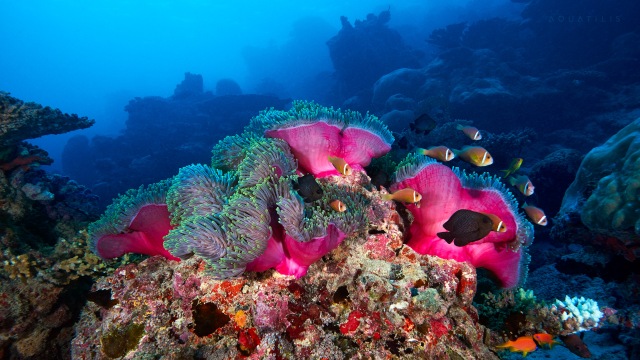What Types of Coral Exist?
When people think about coral they often think about the stony calcified coral they get at a gift shop during a vacation to a tropical island. However, these are only the skeletons of stony corals, and are only one type of coral that exists. There are also deep water and soft corals. Each of these types of corals is unique structurally and in how they interact with their surroundings. There are over two thousand different types of coral which form colonies that play a key role in marine environments.
1. Hard Corals

“Hard Corals” by Amal FM under CC BY-SA 2.0.
Hard coral is a fundamental part of building the coral reef. The polyps of hard corals secrete skeletons of calcium carbonate (Limestone), that will eventually become rock. Hard coral includes species such as brain coral and elkhorn coral. Hard coral are considered to be hermatypes, which are reef-building corals. These corals require a certain type of algae called zooxanthellae that live within their tissues, this important mutualism is necessary for their survival. These organisms are what give corals their colors, which is dependent upon where they are living. The shape and appearance of each coral are dependent upon its species type, location, depth, water movement, and many other factors. Hard coral polyps are very similar to sea anemones, as they also have stinging cells called cnidocytes. Hard coral species can be found in all of the world’s oceans, yet their populations are expected to decrease due to global changes and ocean acidification.
As mentioned earlier, hard corals build coral reefs. A coral reef begins when the coral polyp attaches itself to a rock on the seafloor. This one coral polyp then begins to divide or bud into thousands and thousands of clones of itself. Polyps and their calcareous skeletons connect to one another which creates a colony that will act as one. As this colony grows over hundreds and thousands of years it will join with other colonies and become a reef. Read more in our chapter on coral reef formation.

“Maldives reef” by Alexander Semenov under CC by 2.0
2. Soft Corals

“Soft Corals” by Najim Almisbah under CC by-SA 2.0
Soft corals often resemble plants and trees. They are soft and bendable so they do not have stony skeletons like hard coral. For protection and support, they grow woodlike cores for stability. These cores are made of structural proteins such as gorgonin and other protein similar to those of nails and horns of other animals. These types of coral are referred to as Ahermatypes (non-reef building corals). Examples of soft coral in the Bahamas and Caribbean include sea fingers or sea whips. This type of coral also does not always have a symbiotic relationship with zooxanthellae. Though many utilize their presence, soft corals will typically eat any type of passerby out of the water column. These types of corals do not produce calcium carbonate, rather they contain spiny skeletal sclerites. These give the softer corals some protection and support. Soft species also prefer to live in nutrient-rich waters with less intense light. In other parts of the world, fleshy true soft corals have no rigid internal skeleton at all.
3. Deep-Sea Corals

Deep Sea Coral, White “Black Coral” Leiopathes glaberrima by NOAA Photo Library under CC BY 2.0
Deep-sea coral can be found in the dark depths of up to 6,000 m (20,000 ft) below the surface of the ocean. These corals live in icy cold water with little to no sunlight. These corals, like shallow species, can exist as single polyps or multiple, living in complex colonies made up of different species. Since these species do not require sunlight or warm water, they are able to grow in a vast array of waters around the world. They have even been found in waters as cold as -1-degree celsius. Since these corals live without sunlight they contain no zooxanthellae. This means these corals must obtain their energy and nutrients elsewhere. They do this by trapping tiny organisms in passing currents. The main reason many scientists had no idea of the existence of these deep-sea corals, is because, for many years, the oceans deep depths were inaccessible. In addition to being surprisingly diverse, scientists have also discovered that deep-sea corals are amongst the oldest marine organisms on record. Since corals are constantly growing, regenerating new polyps, some coral reefs have been actively growing for almost 40,000 years. To your and my surprise, scientists have identified nearly as many deep-sea corals as shallow-water species.
The information in this chapter is thanks to content contributions from Haley Zanga, Marisa Benjamin, Haley Fantasia, and Melissa Wydra
